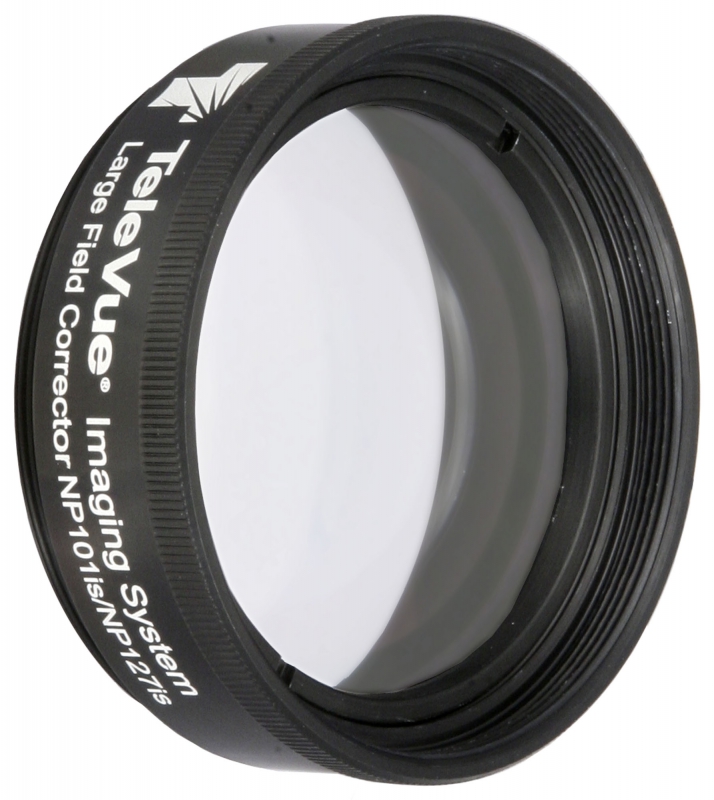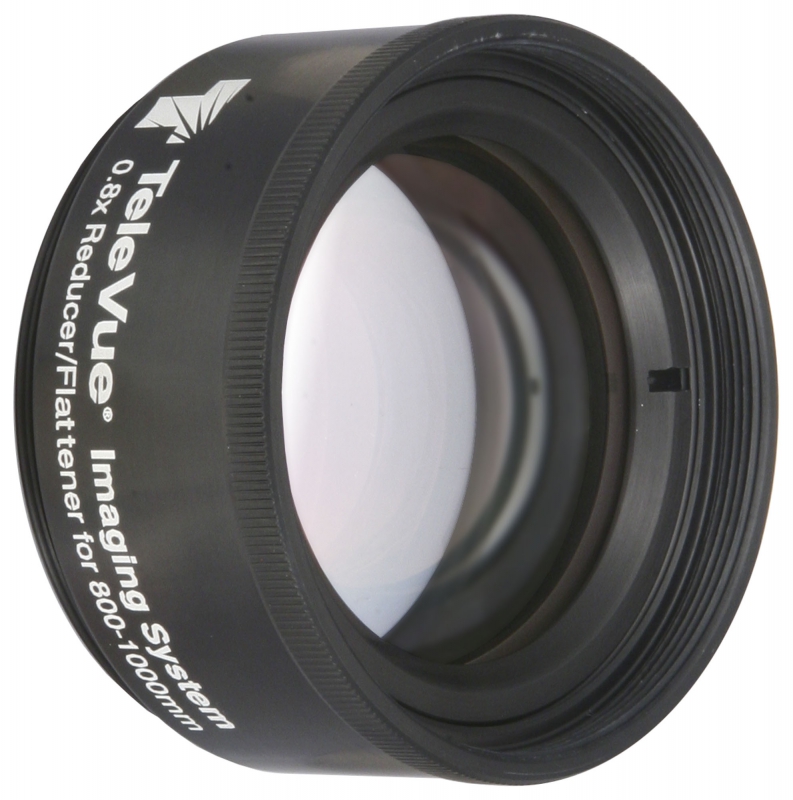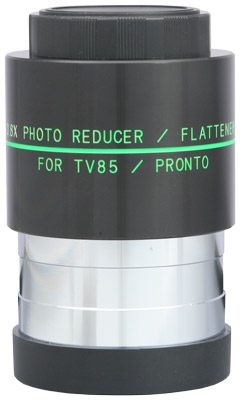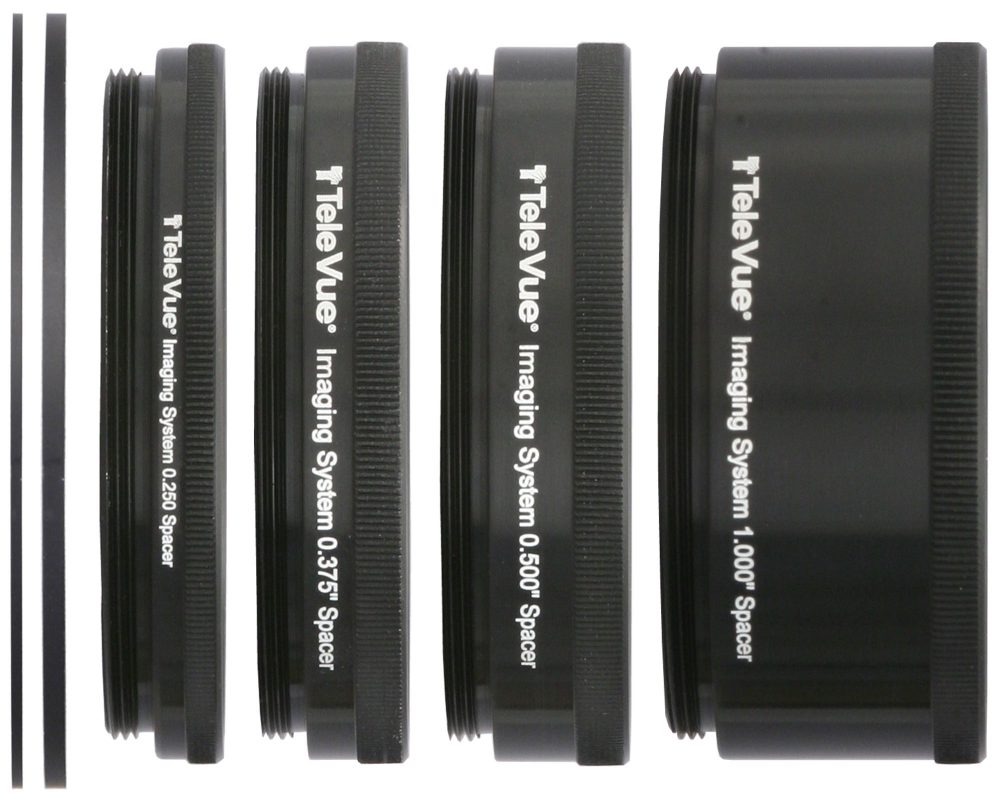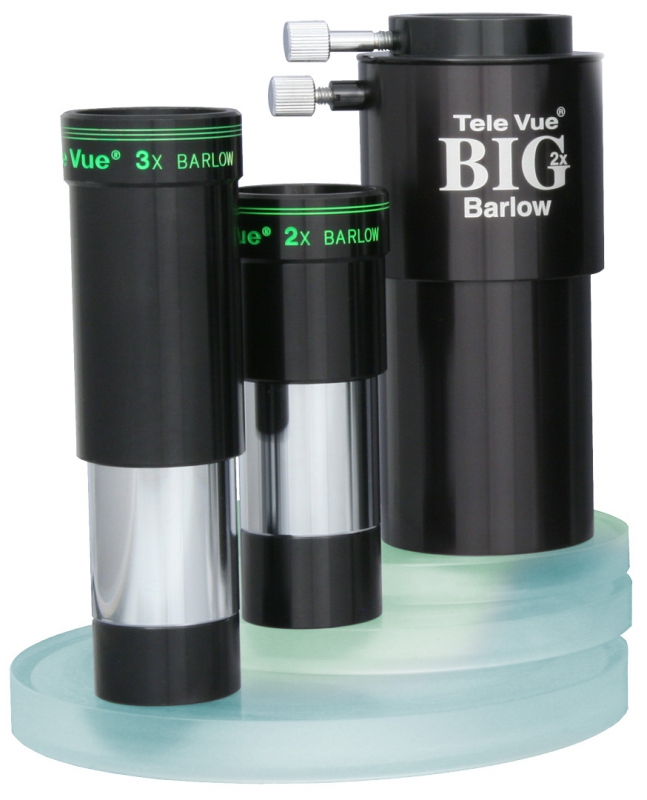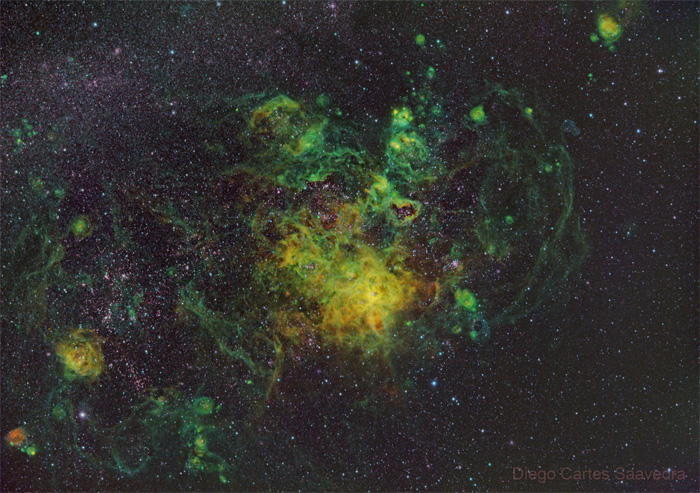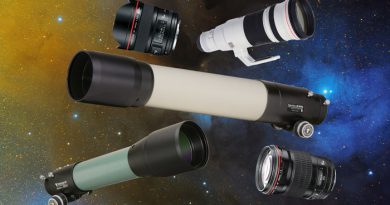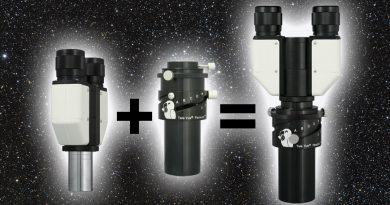Watch Your Back Focus!
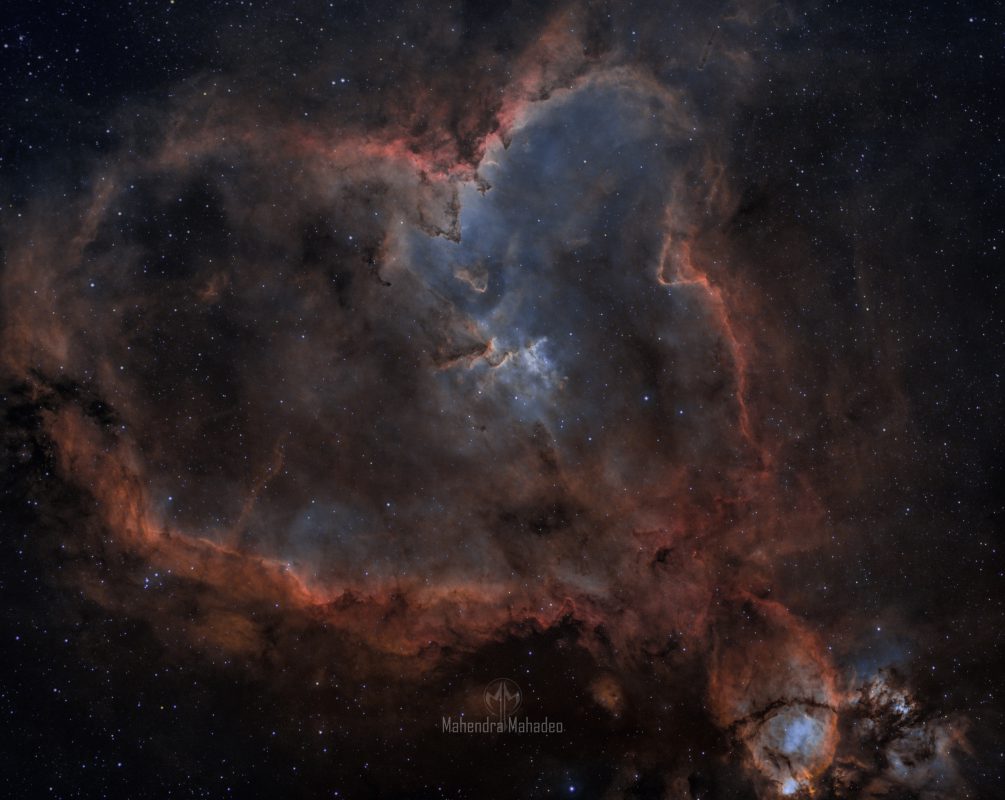
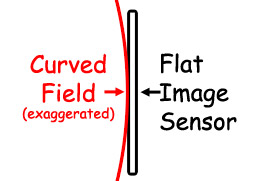
Optical Accessories for Imaging
Most telescopes produce curved image surfaces, meaning that the focus at the center of the field is different than at the edge of the field. While your eye can compensate for some curvature of field, the flat imaging sensor on your camera can’t. So, telescopes can have either built-in or accessory flatteners to flatten the image plane for photography.
Reducers allow the scope to see a greater field of view by shortening the effective focal length of the system. This also naturally lowers (speeds up) the photographic f-ratio which in-turn allows shorter imaging times for non-stellar objects. Reducers are often combined with flattening correction to create a reducer/flattener.
For large sensors covering greater field angles, aberrations in addition to curvature become apparent toward the edge of the field. These can be fixed using correctors specifically designed for your telescope.
To function properly, all of these optical accessories require the camera sensor to be at a certain back focus distance from the correcting optic.
Steps to Determine Back Focus
Here at Tele Vue we often get asked how to achieve the proper back focus for imaging with our Imaging System optical accessories. This involves:
- Determining the Required Distance from Optical Accessory to Sensor
- Determining Your Camera’s Inherent Path Length
- Determining the Path Length of Accessories
- Determine Which Adapter will Connect to our Imaging System
- Determine Required Spacers to Reach Back Focus
In this blog, we’ll go through an example of how this is done.
1) Determining the Required Distance from Optical Accessory to Sensor
For optical accessories to work properly, the camera sensor must be located a prescribed distance from the optic. For Tele Vue Imaging System accessories, we use the flat surface at the base of the male threads on the metalwork as the reference surface since it is easy surface from which to measure. Traditionally, however, the Back Focus distance is measured from the center of the last lens surface to the focal plane. You must look at the instructions for the optic, or the telescope it was designed for, to learn what distance to set.
Continuing with our Imaging System example, the Large Field Corrector (LCL-1069) optimizes the edge of field when imaging through the Tele Vue-NP101is and NP127is telescopes. The “Prime Focus” section in the instructions for the Tele Vue-NP101is says to use a 69.85mm (2.75″) spacing for imaging sensor up to 43mm on the diagonal (full-frame) and 67.82mm (2.67″) for larger sensors. As we said, that distance is measured from the reference surface to the imaging sensor. In addition, if filters are used in the imaging train, for every 3mm of filter thickness, we recommend adding an additional 1mm to the back focus distance.
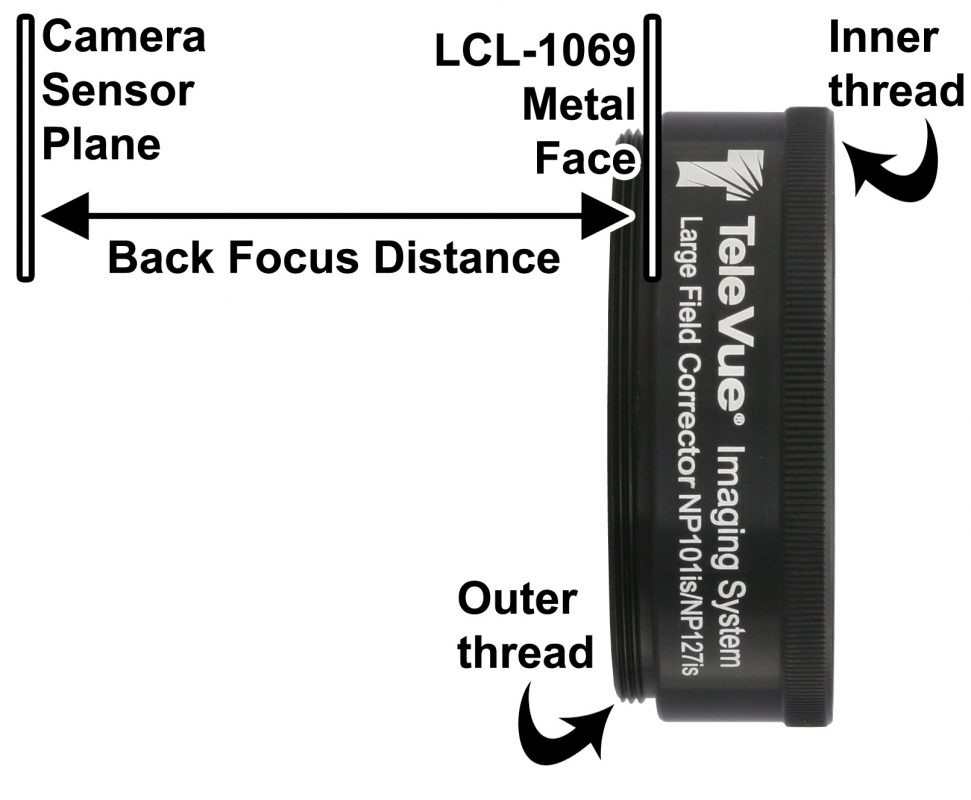
2) Determining Your Camera’s Inherent Path Length
Camera sensors are often recessed from a front reference surface on the camera. For DSLR and Mirrorless cameras, the addition of a T-ring makes the distance from the front face of the T-ring to the sensor an industry standard of exactly 55mm.
For dedicated astronomy cameras, you’ll have to read the camera manual carefully, look at the diagrams, and be prepared to contact the manufacturer with questions. For example, the ZWO ASI6200MM Pro is a popular cooled, full-frame, monochrome camera. We looked through the manual to determine how far back the sensor is recessed from the front of the camera. The “Camera technical specifications” table near the front of the manual says the camera has 17.5mm back focus. This means the sensor is recessed 17.5mm from the front of the camera. On a subsequent “Getting to know your camera” page, the camera is shown with a removable 5mm thick tilt adjust ring with M54 threads on the front. So, does that 17.5mm back focus measurement in the specifications table extended from the face of the tilt ring or the bare face of the camera? We kept looking through the manual and found the “How to use your camera” section showing attachment diagrams with the tilt adjustment ring on and off the face of the camera. With tilt adjuster attached, the diagrams show the back focus distance is 17.5mm and when off it is 12.5mm — the difference being the 5mm thickness of the tilt adjustment ring. So, now we know what 17.5mm back focus refers to the camera with the tilt plate and the 12.5mm back focus is without the tilt plate. The “Getting to know your camera” section states that the protective window in front of the sensor is 2mm thick. In an exchange with ZWO tech support, we were told that the back focus distances stated indeed accounts for the added path length of that window.
3) Determining the Path Length of Accessories
Imagers commonly employ at least a filter wheel/ filter drawer in front of the camera, perhaps an off-axis-guider (OAG), or atmospheric dispersion corrector (ADC) for planetary work. Going back to our ZWO ASI6200MM Pro manual in the “How to use your camera” section, there is an assembly diagram showing a typical setup consisting of the ASI6200MM Pro camera (tilt adjuster removed: 12.5mm) + ZWO-EFW 2″ Filter Wheel (20mm) + M68-OAG (17.5mm) + M54 tilt plate (5mm). This whole assembly from the face of the tilt plate back to the camera sensor has a 55mm distance. To attach this assembly to our TeleVue-NP101is with LCL-1069 requires the spacing to be 69.85mm + 1mm (assuming the filters in the wheel are 3mm thick) for a total of 70.85mm. This means we need to make up 15.85mm of spacing (70.85mm – 55mm).

Determine Which Adapter will Connect to our Imaging System
The first order of business is to choose an adapter to join the ZWO equipment to the Tele Vue imaging system threads on the NP101is using 15.85mm of path length or less. Because the last ZWO part facing the telescope side is the tilt adjuster with M54 thead, We’ll use the Tele Vue M54 Camera Adapter (M54-1073) for this. It has an M54 x 0.75mm male thread on one side and Tele Vue Imaging System inner thread on the other. Once joined to the M54 plate on the ZWO stack, the M54-1073 takes up 6.6mm (0.26″) of the path length so we are left with 9.25mm (15.85mm – 6.6mm) of path left to take up.
5) Determine Required Spacers to Reach Back Focus
In order to reach that final 9.25mm to back focus, we can use a Tele Vue 0.375″ (9.5mm) Accessory Tube (TLB-0375) for this task. It has outer and inner Imaging System threads to connect the M54-1073 to the Large Field Corrector (LCL-1069). You’ll notice that we went 0.25mm “long” with the back focus with this last part. Differences of a millimeter or less are not a problem. What is important is not to round off the calculations to avoid accumulated round-off errors.
Tip: Keep the Light Cone from Vignetting
Beware that narrow aperture accessories in front of the sensor may vignette the image. The problem diminishes with smaller sensors such as the popular 31mm (1.22″) diagonal APS-C chip. In our example, the ASI6200MM Pro has a full-frame sensor with 43.3mm diagonal. That’s why the ZWO 2″ filter wheel, that takes 48mm filters, is used in their example image train sequence and not their smaller 36mm or 1¼” filter wheels. Likewise, the M68-OAG and M54 tilt plate apertures are designed not to interfere with the wider section of the light cone encountered in front of the filter wheel.

Did you observe, sketch, or image with Tele Vue gear? We’ll like your social media post on that if you tag it #televue and the gear used. Example:
#televue #NP101is #heartnebula
Do you want your Tele Vue images re-posted on Tele Vue Optics’ Social Media accounts? Use this hashtag for consideration:
More Info
- Tele Vue Imaging System Accessory Table (mobile site).
- Tele Vue NP101is APO refractor for visual and imaging (mobile site).
- Tele Vue NP127is APO refractor for visual and imaging (mobile site).



